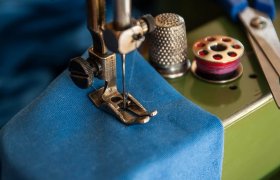How to Make the Most of a Hand me Down Wardrobe

When it comes to being the parent of more than one child, a big expense of the year can easily go to clothing. However having a large family and many friends can be beneficial, especially when applying the hand me down process to your clothing needs.
Creating a system for all the clothes you will use and reuse is essential so you do not forget what you already have and can avoid a cluster in your mind as well as your house. Managing all these clothes can seem to be an overwhelming task taking in mind the seasons and sizes to prep for.
Unfortunately, it is not as simple as separating some shirts from their shorts and pants counterparts. However, you do not need to worry, we have designed some tips and steps for you to manage and make the most of your family’s hand me down wardrobe.
Purchasing Clothes
In the initial monetary investment of hand me downs, we want to buy well-made clothes. Sure you may think that you may have to spend big bucks on name brand to get the durability you need but this is not at all the case.
It just as simple as shopping for the classic, quality items that you can mostly find in the clearance section from the most basic supercenters.
However, when it comes to things like boots, coats sweaters and shoes it is okay to spend the extra dollar on the quality aspect because longevity is key.
Sorting Process
If there has been no sorting from the acquisition of the hand me downs it would be most easy to sort by size first and then sort by season. Usually baby clothes are sorted into 3-month terms; for instance, 0-3 months, 3-6, 6-9 are the typical month spans.

So if your child is born in July you should plan to have the appropriate apparel for 6-9, or possibly 9-12 for those winter and early spring months. Depending on your location this should help when weeding out the items that you really want to keep.
It is okay to be picky, most of all it is important to be idealistic about sorting. It really is not essential to keep all the items that have a sentimental attachment to someone else unless it pertains to you as well and it is on its way to an heirloom.
After the initial sort, we can break the piles of clothes into even more specific sections. The items you want to keep, the ones you want to donate back and the things that would do better just being scrapped.
The reason to sort things out from size first is to make sure there are enough of those sizes to meet the needs of each season. Then you can finally wash everything in each group so there is no need to sort before putting everything away.
Now or the items that you would like to donate. In the instances when you have to keep things in the family for the hand me down rotation they should have their own separate return bin.
When you are ready to get rid of some of those items permanently, they will also have their own allocation. New to you items that happen to not be in decent shape or something that you just have no need for, have one last look through to make sure there is not something you like or can find a use for before shipping that batch out.
For those items that are tattered beyond use and stained to the moon and back go ahead and toss those things out or even recycle at a textile center if possible.
Baby Wardrobe Management
For baby clothes, it would be best to manage and organize a full year of clothing before the newborn is here. It goes without saying but the little potato turns into a full-size watermelon before you know it, and since they can grow through sizes pretty quick, it may be beneficial to keep their clothing stock in an easily accessible place. If you have the closet space in your room it would be great to store them in small bins there.
Toddler Wardrobe Management
When the age of 2 comes rolling around the little one’s clothes are sized by the year and the way to allocate clothes changes a bit. From sizes 2T and above the clothes can be put in larger bins and keeping them in another location like garage, attic, or storage room until necessary. If you are in the possession of an abundance of hand me downs for these clothing sizes we can practice the same method of keeping the ones we want and need, donating the ones we do not, and tossing the ones that would not be useful to anyone.
Around the ages four and five, the kids do not usually need an assortment of clothes for the accidents and spill mishaps. When you get to actually having to put clothes in the closet for your child, this is an ideal time to begin downsizing.
For toddlers around these ages you should keep at least up to two weeks at a minimum of clothes for the summer and winter seasons, as well as some jackets and coats, maybe some extra articles for the cases of accidents and the ones that suffer heavy wear and tear over the course of the year.
If you still have things left over from the original sorting that you like but do not have the room, you can store these elsewhere for another child, or have them for a little freshness to swap out in the middle of the year.
Your kid will love the feeling of having something “new”. Inevitably as the children get older they will develop their own opinions on what they would like to wear, so as seasons pass and clothes do not get used do not feel bad to take them out and replace them.
Older Kids Wardrobe Management

Now coming from the kids discovering their own opinions about clothes, keeping the ones over five years old in hand me downs can become a chore in itself. If you happen to have children that are close in age or size the hand me down process only changes to the fact you do not have to keep as many clothes in reserve, and it most cases you are just moving clothes from one closet to the other.
We have a three-step procedure when it comes to moving clothes from one child down to the next when the seasons change or when one grows out of them.
Starting with the oldest, we can remove the clothes that no longer fit. After five years old it is normal for your kids’ clothes to not go by ages and sizes anymore, and most brands sizes past that point are all different. You will have to discover what sizes are going to be appropriate for your child here.
Again we want to sort the items we are removing and keeping by season. After taking inventory of what is left you want to make sure you have over two weeks of clothes for each season still. If you managed to add more clothes through the year that is no big deal either
One: You should go through the articles of clothing and ensure they are still in good shape, the clothes that are stained or ripped can be removed from the rotation and used as “play” clothes for arts and crafts or outside activities. At this time it is also okay to look into getting a new wardrobe, especially if it is difficult to keep them wearing hand me downs. After making sure what is left has matching elements, you can donate and discard the items that do not.
Two: For the items that are being kept for the next child or if you’re in-between children can be packed and stored. Again some good storage places can be the basement, garage, or even a storage unit until it is time for the preparation of the next size swap. However, if you have a child that is wearing the older one’s hand me downs there should not be much to store. We would recommend the same cycle of operation that we used for the baby and toddler clothes.
Three: Eventually, the hand me down process will slow down and even stop. The kids will wear down there clothes more and find their own style that is specific to them. Not being able to use all the free hand me downs can be a little sad in the realization that your little one is not so little anymore. We know the whole purpose of using used clothes was to keep the wallet healthy, so here is another idea save some cash and possibly keep the used clothes process alive. Make sure to give your favorite local shops a look through at the end of every season and taking advantage of the clearance sections that they will have. Once they start putting clothes out for summer, grab some things for the winter!
Trust us, we know that managing a closet can feel like a stressful task, especially when adding seasonal wardrobes and styles in the process. We hope that sharing this will help you in planning and also help to organize the mountains of clothes a bit more reasonable. In the long run, you will be able to enjoy the immediate savings on clothes for your younger children, and also the self-satisfaction of an organized home.







